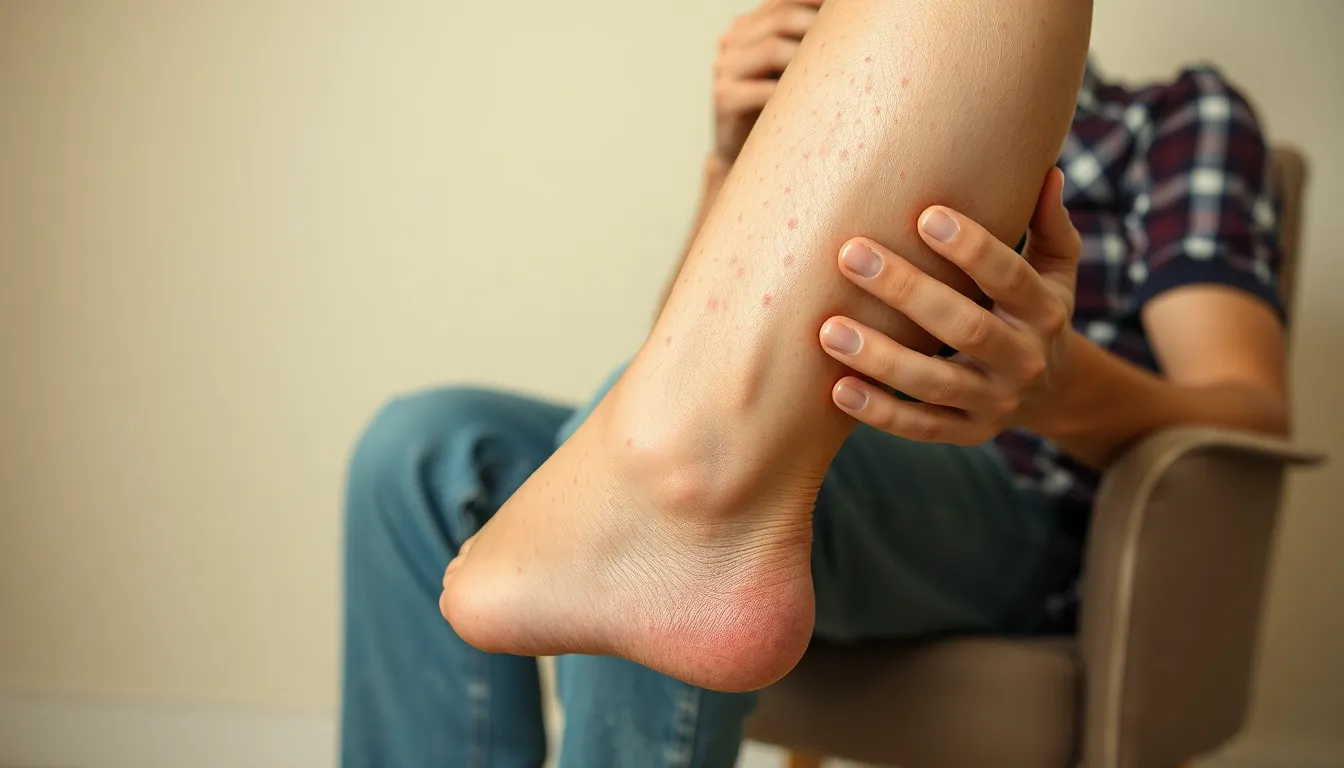Bumps on legs that look like pimples can be a real mystery. One moment you’re enjoying a sunny day, and the next, you’re left wondering if your legs are auditioning for a role in a horror movie. Fear not! These pesky little bumps often have less to do with a scary skin condition and more to do with common culprits like folliculitis or keratosis pilaris.
Table of Contents
ToggleOverview of Bumps on Legs
Bumps on legs that resemble pimples often occur due to various benign conditions. Folliculitis is one common cause, resulting from inflammation or infection of hair follicles. Symptoms often include red, itchy bumps that may resemble acne. Another frequent condition is keratosis pilaris, characterized by small, rough, skin-colored bumps on the thighs and upper arms. This condition stems from a buildup of keratin, a protein that protects skin.
Allergic reactions may also lead to similar bumps. Foods, medications, or topical products can cause localized reactions, manifesting as raised, itchy spots. Insect bites can produce raised, red bumps that closely resemble pimples. These bites may itch and can vary in size depending on the individual’s allergic response.
Skin conditions like eczema can contribute to the formation of red, pimple-like bumps. Often, eczema results in dry, itchy skin with small blisters or pustules. Conversely, viral infections, such as chickenpox, can lead to fluid-filled blisters and lesions that may be confused with pimples.
Even heat rash is a possible culprit, especially in hot and humid conditions. This type of rash often appears as small, itchy bumps where sweat becomes trapped in sweat glands. It’s essential to identify the specific cause of these bumps to determine appropriate treatment and management.
Consulting a healthcare professional proves vital for an accurate diagnosis and tailored treatment plan. Various treatments, including topical creams and lifestyle changes, can help manage these bumps effectively.
Common Causes of Bumps on Legs That Look Like Pimples

Bumps on legs that resemble pimples can arise from various common causes. Understanding these helps identify the right treatment.
Folliculitis
Folliculitis appears when hair follicles become inflamed or infected, causing red, itchy bumps on the skin. Often, these bumps develop after shaving or wearing tight clothing that irritates the follicles. The condition may be mild and resolve without treatment, but persistent cases might require topical antibiotics. Keeping the affected area clean and avoiding irritants significantly aids in recovery.
Keratosis Pilaris
Keratosis pilaris manifests as small, rough, skin-colored bumps, typically on the thighs and upper arms. The underlying cause stems from a buildup of keratin, a protein that protects the skin. It’s a widespread, benign condition often linked to genetics. Regular exfoliation and using moisturizing lotions can help minimize the appearance of these bumps, but complete removal isn’t always achievable.
Allergic Reactions
Allergic reactions can lead to raised, itchy spots resembling pimples. Various allergens, including certain foods, medications, or skincare products, trigger this response. Notably, histamine release causes inflammation and irritation on the skin. Identifying and avoiding allergens is essential for managing these bumps effectively. In some cases, over-the-counter antihistamines may alleviate discomfort and reduce the bumps.
Symptoms and Diagnosis
Recognizing the symptoms linked to bumps on the legs that look like pimples aids in proper identification. Different characteristics help differentiate between conditions.
Identifying the Bumps
Color may vary from red to skin-toned, influencing identification. Size typically remains small, often resembling traditional pimples. Texture differs; some bumps feel rough due to keratosis pilaris, while others feel smooth. Distribution matters; bumps may cluster around hair follicles or spread over larger areas. Accompanying symptoms like itchiness or pain can indicate underlying issues. During self-assessment, monitoring for signs of inflammation or infection proves essential. Regular examination can help distinguish harmless bumps from those needing attention.
When to Seek Medical Attention
Persistent bumps warrant evaluation by a healthcare professional. If bumps exhibit signs of infection, such as increased redness or pus, immediate consultation becomes necessary. Changes in size or appearance might indicate a need for further investigation. Significant discomfort or irritation should not be ignored. Individuals with a history of skin conditions should remain vigilant. Noticing sudden outbreaks or changes demands prompt attention. Relying on a healthcare provider ensures accurate diagnosis and effective treatment options are obtained.
Treatment Options
Bumps on legs that resemble pimples often require targeted treatment to alleviate symptoms. Various methods can address these skin issues effectively.
Home Remedies
Exfoliation aids in removing dead skin cells, helping to reduce bumpiness. Using a gentle scrub a few times per week can enhance skin texture. Moisturizing regularly with a non-comedogenic lotion prevents dryness and irritation. Applying tea tree oil possesses antibacterial properties that may reduce inflammation and prevent infection. Oatmeal baths soothe itchy skin, providing relief from discomfort. Natural remedies like aloe vera gel can also calm irritated areas, promoting healing.
Medical Treatments
Topical antibiotics can address persistent folliculitis, significantly reducing inflammation. In cases of keratosis pilaris, dermatologists may recommend prescription-strength creams containing urea or lactic acid. Prescription antihistamines help manage allergic reactions effectively, alleviating associated itchiness. Corticosteroid creams can relieve inflammation for conditions like eczema that cause similar bumps. Persistent or severe cases might require treatments such as laser therapy to improve skin appearance. Regular consultations with healthcare professionals ensure a tailored approach, optimizing treatment based on individual skin conditions.
Preventive Measures
Regular skincare routines can significantly reduce the occurrence of bumps on the legs resembling pimples. Exfoliation with gentle scrubs helps remove dead skin cells, preventing clogged hair follicles. Moisturizing daily with non-comedogenic lotions keeps the skin hydrated and reduces keratosis pilaris visibility.
Wearing loose-fitting clothing allows for air circulation, which minimizes irritation that tight fabrics can cause. Avoiding hot showers and products with harsh chemicals protects the skin from dryness and inflammation. Individuals prone to folliculitis should consider using antibacterial body washes to reduce bacterial buildup.
Monitoring food intake can also play a role in prevention. Identifying potential allergens in the diet helps reduce reactions that lead to itchy bumps. Using sunscreen protects the skin from UV rays, which can exacerbate pre-existing conditions.
Taking precautions against insect bites is wise for those in high-risk areas. Applying insect repellent contributes to a reduced chance of bites causing red, pimple-like bumps. Staying hydrated can improve overall skin health, enhancing its natural barrier against irritants and infections.
Consulting with a dermatologist provides personalized skincare strategies. Professional advice can pinpoint specific treatments or lifestyle adjustments tailored to individual needs. Regular check-ups help manage any evolving skin conditions effectively.
Bumps on the legs that resemble pimples can be concerning but are often benign. Understanding the potential causes and recognizing symptoms are key to managing these skin issues effectively. With proper self-care routines and awareness of triggers, individuals can minimize their appearance and discomfort.
When in doubt or if symptoms persist seeking professional advice is crucial. A dermatologist can provide tailored treatment options and ensure that any underlying conditions are addressed. Regular monitoring and a proactive approach to skincare can lead to healthier skin and greater peace of mind.


